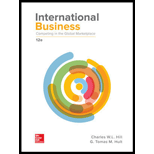
Case summary:
Continent AF has a very little inside trade and has significant trade barriers which limits the movement of goods. AF countries are more likely trade with Countries in E and Countries in A than the other countries. In the year 2015, countries of 26 members joined and create a common market. This is known as tripartite free trade area.
If this becomes successful, then Continent AF can achieve the greater economies of scale and can lower the cost.
Character in the case:
- Countries in continent AF
- Countries in continent E
- Countries in A
To discuss: The reason for Countries in AF to more likely trade with Countries in E and Countries in A than the other countries.
Introduction:
A trade policy which does not restricts the movement of goods and services that is import and export especially on international trade refers to the free trade.
Want to see the full answer?
Check out a sample textbook solution
Chapter 9 Solutions
International Business: Competing in the Global Marketplace
- IM.84 An outdoor equipment manufacturer sells a rugged water bottle to complement its product line. They sell this item to a variety of sporting goods stores and other retailers. The manufacturer offers quantity discounts per the following discount schedule: Option Plan Quantity Price A 1 - 2,399 $5.50 B 2,400 - 3,999 $5.20 C 4,000+ $4.50 A large big-box retailer expects to sell 9,700 units this year. This retailer estimates that it incurs an internal administrative cost of $225 each time it places an order with the manufacturer. Holding cost for the retailer is $55 per case per year. (There are 40 units or water bottles per case.) Based on this information, and not taking into account any quantity discount offers, what is the calculated EOQ (in units)? (Display your answer to the nearest whole number.) Number Based on this information, sort each quantity discount plan from left to right by dragging the MOST preferred option plan to the left, and the LEAST preferred…arrow_forwardDon't used hand raitingarrow_forwardOn 10/6/2024, company A sells goods to Customer C for €20,000 with an agreed credit of two months. On 31/12/2024, in the context of investigating the collectability of its receivables, the company estimates that it will only collect €10,000 from customer C and forms a provision for doubtful debts for the remaining amount. Finally, on 30/3/2025, company A receives from customer C the amount of: a. €9,000 b. €11,000. You are requested to comment on the impact of the above collection cases a. 9000 b. 11,000 on the income statement for fiscal year 2025, justifying your position.arrow_forward
 Foundations of Business (MindTap Course List)MarketingISBN:9781337386920Author:William M. Pride, Robert J. Hughes, Jack R. KapoorPublisher:Cengage Learning
Foundations of Business (MindTap Course List)MarketingISBN:9781337386920Author:William M. Pride, Robert J. Hughes, Jack R. KapoorPublisher:Cengage Learning Foundations of Business - Standalone book (MindTa...MarketingISBN:9781285193946Author:William M. Pride, Robert J. Hughes, Jack R. KapoorPublisher:Cengage Learning
Foundations of Business - Standalone book (MindTa...MarketingISBN:9781285193946Author:William M. Pride, Robert J. Hughes, Jack R. KapoorPublisher:Cengage Learning Contemporary MarketingMarketingISBN:9780357033777Author:Louis E. Boone, David L. KurtzPublisher:Cengage Learning
Contemporary MarketingMarketingISBN:9780357033777Author:Louis E. Boone, David L. KurtzPublisher:Cengage Learning- MarketingMarketingISBN:9780357033791Author:Pride, William MPublisher:South Western Educational Publishing




